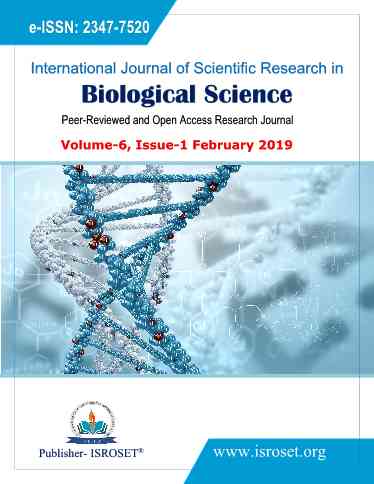Anatomy and stomatal micromorphology of Psophocarpus tetragonolobus (L.) DC. (Winged Bean)
Keywords:
Psophocarpus tetragonolobus, stem, leaf, petiole, root, node, stomataAbstract
Psophocarpus tetragonolobus (winged bean) belongs to the family Fabaceae. It is self-pollinated and growing in the tropical regions of the world. Present study investigated the anatomy of stem, node, petiole, leaf, root and stomatal micro- morphological characters of this species. Stem anatomy showed epidermis, cortical layers (collenchyma and chlorenchyma) schlerencymatous bundle sheath with conjoint, collateral vascular bundle and unilacunar node. One of the distinguishing features in leaf anatomy was the presence of sac like outgrowths filled with simple parenchyma and were usually seen opposite side to the midrib vascular bundle. In the petiole, vascular strands were cylindrical and arc shaped and in roots, four xylem and four phloem patches were present. Paracytic stomata were seen on both sides of the leaves. The stomatal index on adaxial and abaxial surface was 5.54-9.27% and 53.57-61.29% respectively. In general anatomical characteristics of P.tetragonolobus were used for the identification key of this species.
References
T. Hymowitz, J. Boyd, “Origin, Ethnobotany and Agricultural potential of the winged bean—Psophocarpus tetragonolobus”, Economic Botany, Vol.31, pp.180–188, 1977.
O. Smith, J. Ilori, P. Onesirosan, “The proximate composition and nutritive value of the winged bean (Psophocarpus tetragonolobus (L.) DC) for broilers”, Animal Feed Science and Technology, Vol.11, pp.231–237, 1984.
Anon, “The Winged Bean: A high protein crop for the tropics”: National Academy of Sciences, Washington DC. U. S. A, pp.1-43, 1975a.
Anon, “Underexploited tropical plants with promising economic value”, National Academy of Sciences. Washington DC. U. S. A, pp.56-61, 1975b.
Anon, “The winged bean. A high protein crop for the tropics”, National Academy Press, Washington DC, Vol.46, 1981.
G.B. Maesfield, “Psophocarpus tetragonolobus- A crop with a future”. Field Crops, Vol.26, pp.157-176, 1973.
B. Verdcourt, P. Halliday, “A revision of Psophocarpus (Leguminosae-Papilionoideae-Phaseoleae)”, Kew Bulletin, Vol. 33, Issue.2, pp.191-227, 1978.
T.N. Khan, “Papua New Guinea: A Centre of genetic diversity in winged bean (Psophocarpus tetragonolobus (L.) DC”, Euphytica, Vol.25, pp. 693-706, 1976.
Chandra Sekhar Mohanty, Rama Chandra Pradhan, Vinayak Singh, Neha Singh, Rojalin Pattanayak, Om Prakash, Chandan Singh Chanotiya, Prasant Kumar Rout, “Physicochemical analysis of Psophocarpus tetragonolobus (L.) DC seeds with fatty acids and total lipids compositions”, Journal of food science and technology, Vol.52, Issue.6, pp. 3660–3670, 2015.
Shuyi Yang, Aurélie Grall, and Mark A. Chapman, “Origin and diversification of winged bean (Psophocarpus tetragonolobus (L.) DC.), a multipurpose underutilized legume”, American Journal of Botany. Vol.105, Issue.5, pp.1–10, 2018.
V. Kamal Kumar, R. Rajalakshmi, “Polyembryony in Psophocarpus tetragonolobus (L.) DC. from Kerala, India”, Current Science, Vol. 114, Issue. 3, pp.426-427, 2018.
E.J. Salisbury, “On the causes and ecological significance of stomatal frequency, with special reference to the woodland flora”, Philosophical Transactions of the Royal Society, Vol.216, pp.1-65, 1928.
C.R. Metcalfe, L. Chalk, “Anatomy of the dicotyledons I”, Clarendon Press, Oxford, pp.504–516, 1950.
M.B. Marcia da Silva, S.C.O. Asaph Santana, M.M. Rejane Pimentel, C.L. Flavia Silva, P. Karina, Randau, A.L. Luiz Soares, ”anatomy of leaf and stem of Erythrina velutina”, Brazilian journal of Pharmacognosy, Vol.23, Issue.2, pp.200-206, 2012.
Sara Basconsuelo, Monica Grosso, Mirta Graciela Molina, Rosana Malpassi, Teresa Kraus, Cesar Bianco, “Comparative root anatomy of papilionoid Legumes”. Flora. pp. 799-807, 2011.
A.M. Shaheen. “Morphological and cytogenetical variations in the ecological population of Acacia Mill in Egypt”, Ph. D. Thesis, South Valley University, Aswan Faculty of Science, Egypt, 1995.
E.E. Almeida, “Pharmacognostic characterization of Erythrina falcate Benth. Fabaceae”, Brazilian Journal of Pharmacognosy, Vol.20, pp.100-105, 2010.
E.E. Almeida, “Pharmacological characterization of leaves and barks of the species Erythrina speciosa Andrews”, BioFar, Vol.5, pp.34-47, 2011.
M. Erbano, M.R. Duarte, “Centrolobium tomentosum: macro and microscopic diagnosis of the leaf and stem”, Brazilian Journal of Pharmacognosy, Vol.22, pp.249-256, 2012.
S.M.S. Lo, M.R. Duarte, “Morpho-anatomical study of the leaf and stem of paualecrim: Holocalyx balansae”, Brazilian Journal of Pharmacognosy, Vol.21, pp.4-10, 2011.
Downloads
Published
How to Cite
Issue
Section
License

This work is licensed under a Creative Commons Attribution 4.0 International License.
Authors contributing to this journal agree to publish their articles under the Creative Commons Attribution 4.0 International License, allowing third parties to share their work (copy, distribute, transmit) and to adapt it, under the condition that the authors are given credit and that in the event of reuse or distribution, the terms of this license are made clear.







